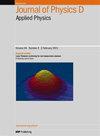从水中的纳秒等离子体中生成钨和铂纳米粒子
IF 3.2
3区 物理与天体物理
Q2 PHYSICS, APPLIED
引用次数: 0
摘要
在钨和铂/铱电极尖端的水中点燃的纳秒等离子体用于制造半径约为 1 纳米的超小型纳米粒子。由于在直径为 10 µm 的电极热点上具有 1016 W m-2 的极高功率密度,表面在短等离子体脉冲期间被烧蚀,金属蒸气在等离子体后的空化泡中膨胀。这就产生了非常大的冷却率,并通过所产生的金属蒸汽冷凝形成纳米颗粒。最后,纳米颗粒分散在液体中。通过阴影测量法测量尖端的净侵蚀,通过透射电子显微镜和 X 射线光电子能谱测量生成的纳米粒子,对这一过程进行量化。结合空化理论对不断扩大的空化泡的凝结过程进行了模拟,结果与实验数据非常吻合。本文章由计算机程序翻译,如有差异,请以英文原文为准。
Creation of tungsten and platinum nanoparticles from nanosecond plasmas in water
Nanosecond plasmas ignited inside water at tungsten and platinum/iridium electrode tips are used to create very small nanoparticles with radii around 1 nm. Due to the very high power density of 1016 W m–2 at an electrode hot spot with a diameter of 10 µ m, the surface is ablated during the short plasma pulse, and the metal vapour expands in the cavitation bubble after the plasma. This creates a very large cooling rate and the formation of nanoparticles by condensation from the created metal vapour. Finally, the nanoparticles disperse in the liquid. This sequence is quantified by measuring the net tip erosion by shadowgraphy and the created nanoparticles by transmission electron microscopy and x-ray photoelectron spectroscopy. The condensation process is modelled in conjunction with cavitation theory for the expanding cavitation bubble, which shows very good agreement with experimental data.
求助全文
通过发布文献求助,成功后即可免费获取论文全文。
去求助
来源期刊
CiteScore
6.80
自引率
8.80%
发文量
835
审稿时长
2.1 months
期刊介绍:
This journal is concerned with all aspects of applied physics research, from biophysics, magnetism, plasmas and semiconductors to the structure and properties of matter.

 求助内容:
求助内容: 应助结果提醒方式:
应助结果提醒方式:


